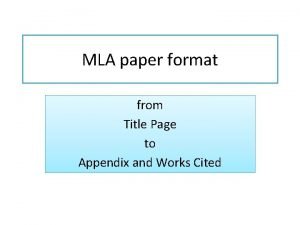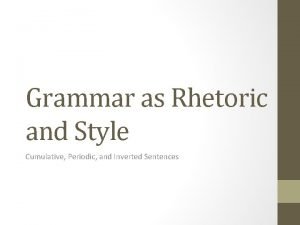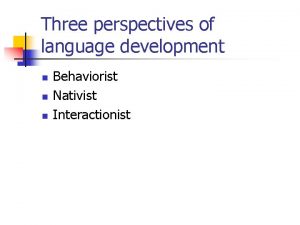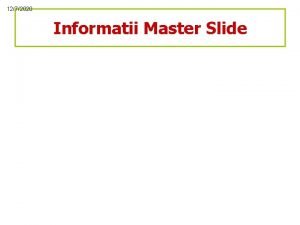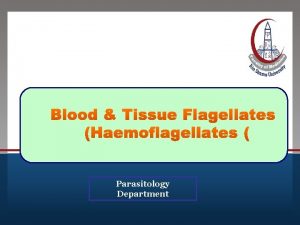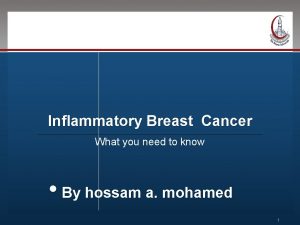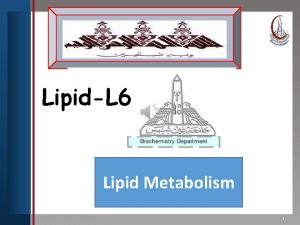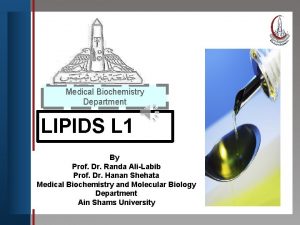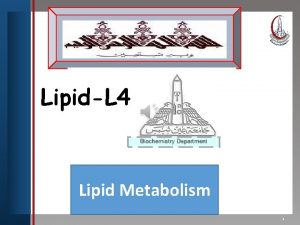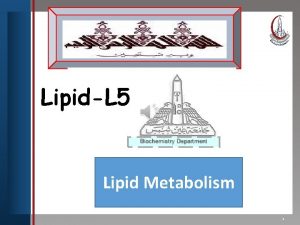Click to edit Master title style Edit Master

























- Slides: 25

Click to edit Master title style • Edit Master text styles • Second level • Third level Hypoxia Cyanosis & O 2 Therapy • Fourth level • Fifth level Professor. Abdelhamid@med. asu. edu. eg

Hypoxia • Insufficient O 2 supply at tissue level. Hypoxemia • Decrease PO 2 in the blood. Anoxia • Complete absence of O 2 in the tissues. • Hypoxemia is always associated with hypoxia. • Hypoxia is not always associated with hypoxemia. • Explain……….

O 2 consumption by tissues depends on: 1 - The SUPPLY of oxygen to lungs during inspiration. 2 - The TRANSFER of oxygen from the alveoli to the pulmonary capillaries. 3 - The TRANSPORTATION of oxygen by the blood to the tissues. 4 - The UTILIZATION of oxygen by the tissues.

Oxygen Cascade This represents the series of partial pressure of oxygen (PO 2) decline from Atmosphere (at sea level) to the Mitochondria in the cell. It is formed by the following pressures: 1 - Atmospheric Air = 160 mm. Hg 2 - Humidified Tracheal Gas = 150 mm. Hg 3 - The Alveolar Gas = 106 mm. Hg 4 - The Arterial Blood = 100 mm. Hg 5 - The Capillary Blood = 45 -55 mm. Hg 6 - The Mitochondria = 7. 5 -40 mm. Hg Reduction of PO 2 at any stage in the cascade causes reduction in subsequent steps. This risks inadequate mitochondrial PO 2 for AEROBIC METABOLISM.

Click to edit Master title style Types of hypoxia • Edit Master text styles 1 - Hypoxic Hypoxia: in inadequate arterial oxygenation • Second level • Third level 2 - Anemic Hypoxia: in inadequate hemoglobin content or function • Fourth level 3 - Circulatory (stagnant) Hypoxia: in inadequate perfusion • Fifth level 4 - Histotoxic (cytotoxic) Hypoxia: in inability of the cell to utilize oxygen

Types of hypoxia • Hypoxic hypoxia: Def: inadequate oxygenation of arterial blood Causes: - Decreased O 2 in inspired air. - Decreased ventilation. - Decreased diffusion. - Ventilation/ Perfusion mismatching. - Right to left shunt.

Click to edit Master title style Decreased Ventilation -Resp. center depression. -Resp. ms paralysis. -Pneumothorax. • Edit Master text styles -Increased airway resistance. Decreased O • 2 Second level -Decreased lung elasticity in inspired air • Third level (high altitude) • Fourth level • Fifth level Right to left Shunt -Shunting of venous blood into arterial blood (cyanotic congenital heart disease) Decreased diffusion -Pneumonia. -Congestion. -Fibrosis. Vent. / Perf. imbalance -Hypoventilated or nonventilated alveoli.

Types of hypoxia • Anemic hypoxia: Def: inadequate oxygen carrying capacity of arterial blood Causes: - Quantitative Anemia: due to decreased level of Hb, as in all cases of usual anemias. - Qualitative Anemia: due to non-functioning Hb, as in CO poisoining.

Click to edit Master title style Carbon monoxide poisoning • Edit Master text styles CO combines with Hb at the same point combines where O 2 • Third level • Second level where O • • Fourth level • Fifth level • CO has 250 times more affinity to Hb than O 2 • Shifts O 2 -Hb dissociation curve to left • Treated with 100% O 2

Types of hypoxia • Stagnant (Ischemic) hypoxia: Def: inadequate supply of arterial blood to tissues. Causes: - Localized: obstruction of a tissue blood flow. - Generalized: • Hemorrhage. • Circulatory failure.

Types of hypoxia • Histotoxic (Cytotoxic) hypoxia: Def: inadequate oxygen utilization by tissues. Causes: - Cytochrome oxidase inhibition as in cyanide poisoning.

Hypoxic Hypoxia Anemic Hypoxia Ischemic Hypoxia Histotoxic Hypoxia Cause Decreased PO 2 in arterial blood Decreased available Hb Decreased tissue blood flow Inability of cells to use O 2 PO 2 Decreased Normal O 2 content Decreased Normal Hypoxemia

Manifestations of hypoxia -Headache. -Loss of appetite. -Tachycardia. -Drowsiness. -Nausea. -Easy fatigability. -Vomiting. -Tachypnea.

Oxygen therapy in hypoxia Hypoxic Hypoxia O 2 therapy is - Decreased O 2 in air. useful - Decreased ventilation. - Decreased diffusion O 2 therapy is -Ventilation/ perfusion useless imbalance. - Right to left shunt. Anemic Hypoxia Ischemic Hypoxia CO poisoning (use hyperbaric O 2) -Decreased in all its types amount of Hb. (usual anemia) Histotoxic Hypoxia use hyperbaric O 2 & treat the cyanide by nitrites and methylene blue.

Click to edit Master title style Oxygen Therapy Apparatus Requirements • 1 -Edit Master text styles Inspired Oxygen Concentration (Fi. O 2) Control of Fractional • Second level 2 - Prevention of CO 2 -Accumulation • Third level • Fourth level 3 - Minimal Resistance to Breathing • Fifth level 4 - Acceptable to the Patient

OXYGEN THERAPY Indications 1 - Cardio Pulmonary Resuscitation (CPR) 2 - Respiratory Failure 3 - Cardiac Failure 4 - Shock of any Cause 5 - Increased Metabolic Demands 6 - Carbon Monoxide (CO)-Poisoning 7 - Postoperative States

Hyperbaric O 2 Therapy - Disadvantages: • Oxygen toxicity will occur early • Inhibits tissue enzyme activity • Cerebral vasoconstriction • Muscular twitches, tinnitus, convulsions and coma

Click. Oxygen to edit Master title style toxicity • Edit Master text styles • Second level • Third level • Fourth level - Retrolental fibroplasia & • Fifth level blindness in premature infants (due to VC of retinal Bl. Vs. ) - Dizziness, convulsion & coma (VC of cerebral Bl. Vs. ) For 8 hours or more: - Tracheobronchial irritation - Nasal congestion. - Twitching. - Sore throat. - Coughing.

Types of Oxygen Therapy Apparatus 1 - Fixed Performance Systems : A- High Flow Venturi -Type Mask B- Low Flow Anesthesia Breathing System (with CO 2 -absorber) 2 - Variable Performance Systems : A- No Capacity Systems - Nasal Catheter with Low Flow B- Small Capacity Systems – a- Nasal Catheter with High Flow b- Simple Face Mask c- Tracheostomy Mask or T-Piece d- Face Tent C- Large Capacity Systems – a- Soft Plastic Mask b- Oxygen Head Box c- Oxygen Tent d- Incubator


Methods of Oxygen therapy Click to edit Master title style • Edit Master text styles • Second level • Third level • Fourth level • Fifth level Nasal Cannula Portable set Mask Mechanical ventilator

Cyanosis • Definition: Bluish discoloration of the skin mucous membrane (Lips, nail beds, ear lobes). • Threshold of appearance: It appears when the amount of reduced Hb in capillaries is increased above 5 gm/100 ml blood.

Cyanosis • Conditions with cyanosis: - Exposure to moderate cold: Because of more O 2 extraction from Hb, thus increasing the % of reduced Hb. - Polycythemia: Because of the high Hb content (it is easy to get 5 gm reduced Hb / 100 blood) - Hypoxic hypoxia: Because of low O 2 in blood. - Stagnant hypoxia: Because of more O 2 extraction from Hb of the stagnant blood & addition of CO 2. - Asphyxia: Because there are both O 2 lack & CO 2 excess.

Cyanosis • Conditions without cyanosis: - Exposure to severe cold: Because of little tissue needs & less O 2 extraction from Hb (shift to the left of O 2–Hb curve) - Anemic hypoxia: Because of the low Hb content (it is not easy to get 5 gm reduced Hb / 100 blood) - CO poisoning: Because of the cherry red color of carboxyhemoglobin. - Histotoxic hypoxia. Because of the normal O 2 content of blood which is not taken by tissues.

 Click to edit master title style
Click to edit master title style Title style
Title style Click to edit master title style
Click to edit master title style Click to edit master title style
Click to edit master title style Soft edit meaning
Soft edit meaning Click clever click safe
Click clever click safe Safety click
Safety click Cyber safety
Cyber safety Click clever click safe
Click clever click safe Master title style
Master title style Master title style
Master title style Click to add title
Click to add title Click to add title ne demek
Click to add title ne demek Add your title here
Add your title here Title title
Title title Title fly and title page
Title fly and title page Appendix in a paper
Appendix in a paper Top right corner of the page
Top right corner of the page Apa title
Apa title Informal writing styles
Informal writing styles Cumulative sentence
Cumulative sentence Informal vs formal writing
Informal vs formal writing Referential vs expressive style
Referential vs expressive style Modified block style format
Modified block style format Inversion in poetry
Inversion in poetry What is a slide-title master pair
What is a slide-title master pair
















